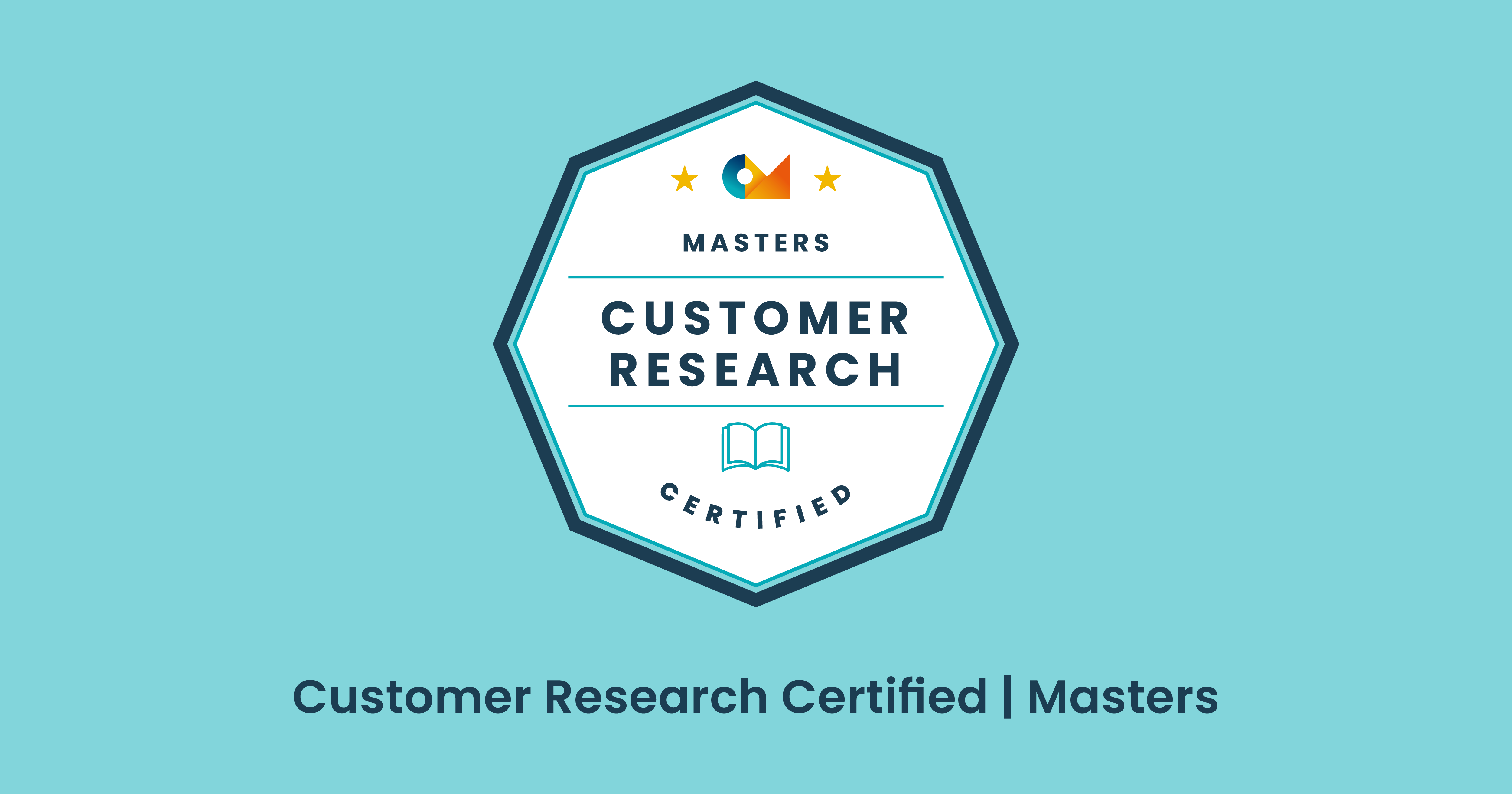In this guide, you’ll learn almost everything you need to know about market research, including, but not limited, to:
- What market research is,
- Types of market research,
- How it supports other customer marketing concepts,
- What a market research strategy is,
- Five types of market research questions, and
- Five common stumbling blocks.
What is market research?
Market research is a concept not limited to customer marketing, but a strategy that’s essential for the success of every single part of the business. The main aim of this research is to gather and analyze information including:
- Target market,
- Target audience,
- The current industry landscape
- Current and upcoming competitors
Analyzing this type of information can help you make informed decisions about the direction of your business, which is vital for its success.

Types of market research
Market research is somewhat of an umbrella term in which a number of different research methods happen. This can include:
Customer research
This is research focussing on existing and potential customers and their attitudes toward your product.
Competitive intelligence
This is all about understanding your competitor's strengths and weaknesses in order to give yourself a competitive advantage.
Market segmentation
This refers to a broader type of customer segmentation, where you segment types of consumers. This’ll identify common needs, the distinction between these groups, and how they respond to the industry market.
Product testing
Product testing, as it refers to market research, is about testing audiences' reactions to a product not yet launched.
Advertising testing
Pre-test surveys, qualitative testing, biometrics, and A/B testing.
Customer satisfaction and loyalty analysis
These methods are pretty self-explanatory: Satisfaction is about measuring the satisfaction of your existing customer base for your product and your business. Customer loyalty is about how loyal your customers are in their purchasing and engagement. Believe us: the difference between these two is important.
Brand research
This is about the presence your brand has. Is your brand easily identified and memorable? Can your brand reach more consumers?
Pricing research
This is a research type that investigates your customers' willingness to pay for your products or services. This will explore how changes in prices impacts demand.
These are by no means all of the types of research within market research; it’s incredibly comprehensive but is a fantastic way to support your business goals.
We go into much more detail about brand research, campaign effectiveness, competitive analysis, product development, and usability testing in the article below.

How market research supports marketing
When it comes to marketing, market research will impact the type of content, tone, style, and campaigns you’ll use. As marketing is centered around engaging with your customers, most of the reach will come under the customer research side of it.
Most notably, improving marketing strategies will come from customer feedback, because interacting with your customers involves engaging in a way that’s personal to each one.
Engaging with things like customer behavior and customer segmentation can open up a variety of strategies such as Voice of the Customer (VoC), FOMO marketing, Customer Advisory Boards (CABs), Consumer Psychology, and more to truly launch your marketing strategies to success.

How to conduct market research
As mentioned, market research is usually very time-consuming and intensive, especially when doing it for the first time. But whether you’re a start-up or an enterprise company, market research will always be relevant. We’ve got a guide on market research for startups below which goes through the ways you can prioritize your research to be cost-effective:

Though you’ll want to make changes to how you conduct your research, the basic steps are going to be the same for everyone:
Set your goal
As with any strategy or research process, the first thing to do is to define your problem and set your goal to solve said problem. Going into market research without a defined goal in mind is very a common mistake; market research is invaluable so while many marketers know they need to do it, they forget to make it specific to their brands' needs.
You’ll need to do a little bit of introspection before you begin your market research in full;
- Where is your company falling behind?
- What had changed in the market recently?
- Are you reaching all of your potential customers?
- Has a recent project produced some interesting results?
Once you’ve defined the goal you’ll know the kind of data you’ll need to collect. Consider the following:
- What is the scope of this research?
- What kind of data do you need to help answer your problem?
- What parts of the business will be impacted by your findings?
- Which variables will you be investigating?
For example - Let's say you’ve just introduced a new community platform but your customers aren’t using it. You’ll need to find out why they’re not using it.
- Is there a new community run by a competitor that they prefer?
- Are there specific features your target audience needs that yours doesn’t have?
- If you charge for the platform, is the subscription cost too high?
Develop a research plan
Narrowing down an ideal research plan can be a little tricky, as there are a whole bunch of ways to collect data, all of which will produce slightly different results. Keep your goal in mind when choosing your methods.
What are some good market research plans?
Here are a few options for collecting data:
Surveys
Using a survey can be a quick win way of collecting data from your customers if done correctly. But the key thing is to ensure that your questions are relevant and specific enough actually to answer what you’re investigating.
The wording is extremely important when writing these questions because if a question can be interpreted differently, you may get answers you can’t use.
Don’t make your survey too long
Your customer’s time is precious and you don’t want their attention on your brand to be taken up with answering a really long survey.
Five types of market research questions
- Demographic questions - Starting simple, these questions will be about age, gender, location, and more. That'll give you insights into the existing audience interested in your product or service, and perhaps show you some demographics your marketing is missing.
- Behavioral questions - These will be questions related to lifestyle, specifically how their behavior relates to how they use your product.
- Competitor analysis - Ask them about your competitors too. What do they prefer from other companies?
- Product questions - Ask them what they like and dislike about the product. Do they have preferred use cases and features?
- Pricing questions - These questions can gauge how much your customers are willing to pay for your product and any additional features. What might be stopping them from paying the current price points?
Interviews
These can be a one-to-one interview, or group studies such as focus groups, all of which will produce more in-depth but less broad answers to your investigation. These kinds of interviews actually benefit more open questions as the customer is in the room with you so you can clarify their answers then and there.
User tests
Running user testing can be a cost-effective way to get information about your customer’s behavior habits on your website. Using things like A/B testing can also help inform the type of tone of voice and messaging that best suits your target audience.
Social media
Be it polls, comments, or threads, social media is a fantastic way to get insights from your customers in real-time.
Analyse data
Now we’ve gone through the methods of collecting the data, the next step is to analyze it. With all these strategies, this is one of the most important stages. It’s completely pointless to go through the first two stages if you’re only going to gather data and not actually go through it.
The first step is to organize your data. If that's in a spreadsheet or in another tool, make sure you choose and stick to one way of organizing this data - and again make sure it makes sense for what you’re investigating.
When you’re analyzing the results, make sure to not focus on outstanding bits of data, but rather on trends that occur throughout the whole set.
Another part of this is in how you represent that data to others. Be it a summary or visual graphs, making the data accessible to others is a great way to represent the results to others.
Put results into action
The final step is to come up with action plans to put the results of this analysis into action. These will be determined by your budget and resources along with your customer base and if you’re a B2B or B2C business.
Be this changing your tone of voice, adding new features, adjusting your common practices, or more, making these changes is important to the future success of your business and its marketing practices.
Five common stumbling blocks
Here are some of the most common stumbling blocks when it comes to conducting market research:
Under-defining or over-defining your objectives
Starting with a goal in mind is vital otherwise your research will have no direction and will be a waste of time and resources. But defining your objectives too much could lead to an unwillingness to take in data that is contrary to your goal.
Ambiguous questions
Ambiguous questions can lead to answers that aren’t useful to your research. If there are too many questions that customers can interpret in different ways you may have just wasted your time and ended up with data that you can’t actually use to make plans.
Overusing surveys
Survey fatigue is a very real thing, and while surveys can be very tempting as they’re generally quick and easy to produce, they’re only useful if people answer them. If you’re conducting other research alongside your market research, you can very well end up asking your customers to complete multiple surveys in a single span of time.
In this scenario, you’ll not only be splitting your customer's attention - most likely resulting in fewer data for all of your surveys - but will also reduce UX as your customers will be bombarded with things they need to do for you, without you offering a reason for them to put their time into supporting your research.
Introducing bias
Though it may be tempting to direct your audience in certain ways, doing so will result in a disingenuous presentation of your current place in the market.
Though you may even feel that you know better than your customers when it comes to things like marketing tactics, tone of voice, or your competitors, discouraging answers that come out through your investigation will mean that you’ll miss out on the opportunity to make improvements to your processes that are needed.
Packing your report with too much data
The reason for conducting this research is to identify areas of improvement and opportunities for expansion and growth. If the report isn’t easy to navigate (if it's overloaded with graphs and data) then no one is going to know where to start when making plans from this research.
Customer research
As we mentioned before, customer research is categorized within market research, but is more specialized in its investigation, prioritizing research around the customer over produce and competitive intelligence.
Customer research, when done right, can enhance every essential aspect of customer marketing. Accurately marketing to your customers means knowing them from the inside and out, knowing their needs, pain points, and interests, and turning that into actionable steps to take your customer marketing to the next level.
Our Customer Research Certified course will take you through the fundamentals of conducting accurate and representative customer research, leaving no stone unturned.
You’ll be taken through a practical and actionable step-by-step framework that’ll define your customer’s story, create a true voice of the customer, and action real business change.


 9 min read
9 min read
 Follow us on LinkedIn
Follow us on LinkedIn




